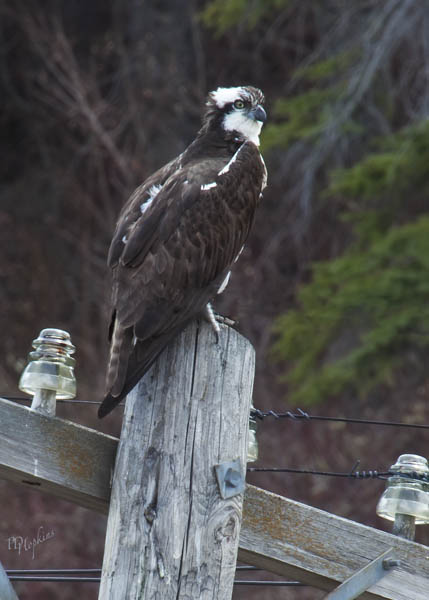I’ve been watching a family of ospreys for the past three years. A pair of these large raptors return each spring to nest atop a power pole along the railway tracks, east of Canmore. The osprey couple give birth to 2-3 chicks each year and fledge them over the course of the summer before leaving for warmer climes in the fall. I’m not sure where they go each winter (probably Phoenix, like other Albertans) but they do remain together and return to the same nest every year. They’re back and I was able to get some shots of the male who was standing guard over the nest while perched atop a nearby power pole. His mate was largely obscured by the sides of the nest and I couldn’t get a good picture of her today. I presume she was busy keeping the eggs warm.

Following is some information on the osprey if you’re interested in learning more about this magnificent bird.
The Osprey, sometimes known as the sea hawk or fish eagle, is a large raptor, reaching 60 centimetres (24 in) in length with a 2m wingspan. One of the largest birds of prey in North America, the Osprey eats almost exclusively fish. It is one of the most widespread birds in the world, found on all continents except Antarctica.
The Osprey readily builds its nest on manmade structures, such as telephone poles, channel markers, duck blinds, and nest platforms designed especially for it. Such platforms have become an important tool in reestablishing Ospreys in areas where they had disappeared. In some areas nests are placed almost exclusively on artificial structures.
Osprey eggs do not hatch all at once, but instead the first chick hatches out up to five days before the last one. The older chick dominates its younger siblings, and can monopolize the food brought by the parents. If food is abundant, little aggression is seen amongst the chicks, but if food is limited, the younger chicks often starve.
The Osprey is a fish-eating specialist, with live fish accounting for about 99% of its diet. Barbed pads on the soles of its feet help it grip slippery fish. When an Osprey takes a large fish to its nest, it carries the fish headfirst to make it as aerodynamic as possib
Information courtesy of the Cornell Lab of Ornithology.

Great shot Peter. Raptors are such wonderful birds to observe. Hope you can get some pictures of the young ones in time. Last summer we saw many of their nests in the Kootany area. I did not realize that their wingspan is as great as two m.!